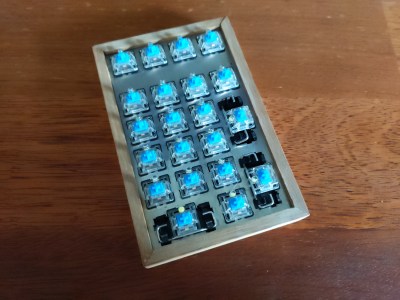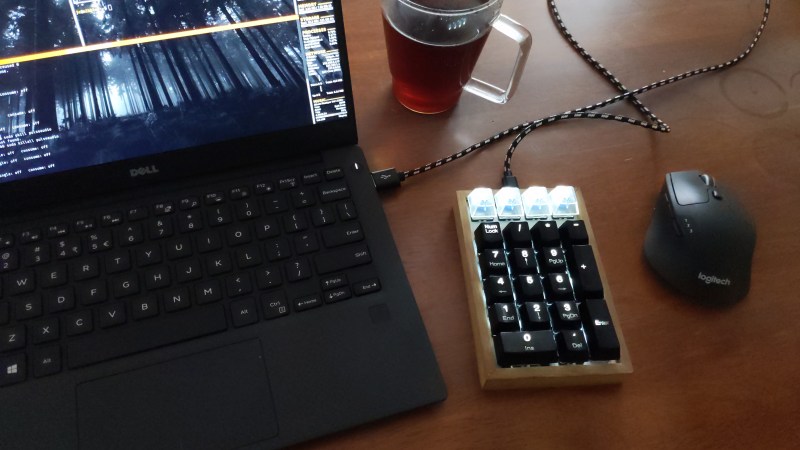Why buy a num pad or a macropad when you can build something new and beautiful, open source that bad boy, and be a hero to the community? We think that should be all the justification you ever need to build instead of buy, even if you think your thing is Just Another Keypad [JAnK] as [Clewsy] claims.
 At first glance, JAnK appears to be a standard number pad with four macro keys across the top. But when you roll your own ‘board, all the keys are programmable. [Clewsy] took advantage of this by adding a second layer that’s accessible with (what else?) the Num Lock key. This switches JAnK over to 21-key macro pad mode.
At first glance, JAnK appears to be a standard number pad with four macro keys across the top. But when you roll your own ‘board, all the keys are programmable. [Clewsy] took advantage of this by adding a second layer that’s accessible with (what else?) the Num Lock key. This switches JAnK over to 21-key macro pad mode.
[Clewsy] rolled their own PCB for this and used the venerable ATMega32u4 because of its HID and USB host capabilities. Every key is backlit, and these LEDs are driven by an MP3202 LED driver and PWM from the AVR. [Clewsy] was able to build a prototype by sawing the num pad off of a stainless steel key switch plate from another build, but eventually ordered JAnK its own custom, laser-cut, stainless steel plate. The lovely enclosure is made of spotted gum wood and an acrylic base.
Putting it all together proved to be a bit problematic. [Clewsy] soldered up the minimum viable components for testing and discovered that the ATMega’s VCC and GND pins were both shorted. This killed the AVR programmer, but not the chip itself, and [Clewsy] happened to have a spare. To add insult to injury, the Num Lock light didn’t work, but [Clewsy] was able to simply reverse the LED instead of ordering a new pile of boards. Check out the detailed write-up with code and tons of pictures over on [Clewsy]’s personal site.
One of the awesome things about this build is that [Clewsy] was able to re-use the code from macr0, which began life as a proof of concept for scanning key matrices, and retired to become a music and media controller.















Interesting. I just saw a usb numeric keypad in the dollar store for ~$3. I thought about buying it and making a macro pad out of it, but then I thought, “a macro pad with no little screens on each of the keys to change out the labels under context is not much different than just remembering a bunch of keyboard shortcuts.” So I didn’t buy it. This project suffers from the same limitation. If I have to print out a list of which key does what or memorize them all, I’d rather just stick to a regular keyboard or click with the mouse. This is definitely better than what I was planning on doing, but mine would have come in a lot cheaper. Neither is better than a macro pad with little screens.
Someone did a keyboard with “little screens” on every key… little OLED screens on a full-size 101-key keyboard.
Heinously expensive. Even scaling that down to macro-pad size, I doubt you’d do the screens for less than maybe 50c each.
That is why you won’t see one for $3.
Yeah, and if you want off the shelf parts like the NKK Smartdisplay switches, you pay around 50$ per key, so thats a bit expensive. I guess at that point you are better off just buying a streamdeck or going for a programmable touch display. You could use an old/cheap smartphone and just install Touch Portal too…
I’ve always wondered whether you could “project” an image onto the under-surface of a keycap using some sort of miniature LED dot-matrix projector arrangement under the key cap and a periscope mirror set-up to “reflect” the image around the stem of the key switch.
Still, a lot more piss-farting around than a company wanting to flog them off for $3 retail is going to want to attempt.
Just use a medium sized LCD with touch capability…
Art Lebedev with his Optimus Maximus keyboard.
https://en.m.wikipedia.org/wiki/Optimus_Maximus_keyboard
Awesome job !